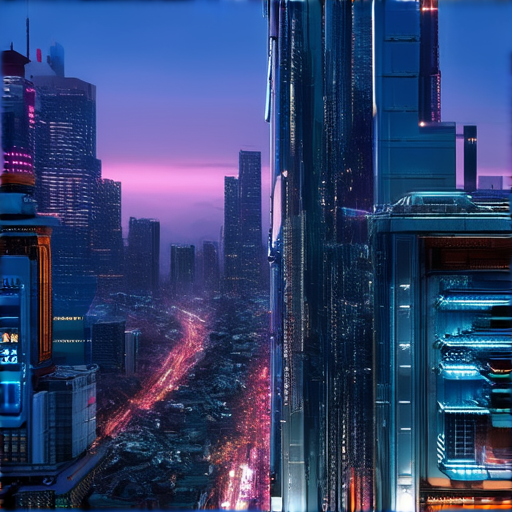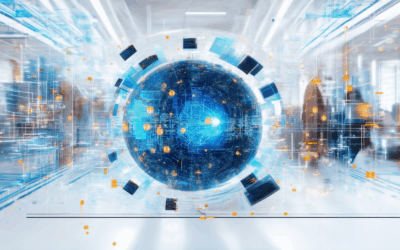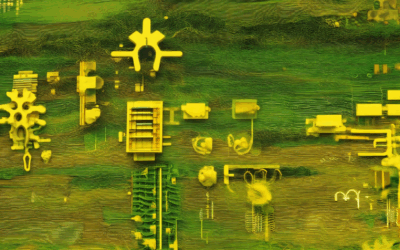The world of technology is constantly evolving, with new innovations and advancements emerging every day. As we navigate through the ever-changing landscape of technological progress, it’s essential to stay informed about the latest trends and developments that are shaping the future. From artificial intelligence and blockchain to the Internet of Things (IoT) and cloud computing, there are numerous emerging trends in technology that are revolutionizing the way we live, work, and interact with one another.

Emerging Technology Trend
We’re living in an era of rapid technological advancement, with innovations transforming industries and revolutionizing the way we live and work.
-
Artificial Intelligence (AI)
AI continues to gain momentum, with its applications expanding into various sectors, including healthcare, finance, and education.
- Machine learning algorithms are being used to develop personalized medicine and predictive analytics.
- Natural language processing (NLP) is enabling chatbots and virtual assistants to become increasingly sophisticated.
-
Internet of Things (IoT)
The IoT is connecting devices, sensors, and systems, creating a vast network of interconnected objects.
- Smart homes and cities are becoming a reality, with energy-efficient systems and real-time monitoring.
- Industrial automation is increasing productivity and reducing costs through optimized processes and predictive maintenance.
-
Blockchain
Blockchain technology is disrupting traditional financial systems, offering secure, transparent, and decentralized transactions.
- Cryptocurrencies like Bitcoin and Ethereum are gaining mainstream acceptance.
- Supply chain management is becoming more efficient, with real-time tracking and verification of goods.
-
5G Networks
The rollout of 5G networks is transforming mobile communication, enabling faster data transfer rates and lower latency.
- Enhanced mobile broadband (eMBB) is supporting high-speed internet access and streaming services.
- Ultra-reliable low-latency communications (URLLC) are critical for mission-critical applications, such as remote healthcare and autonomous vehicles.
-
Low Earth Orbit Satellites
LEO satellites are providing global connectivity, bridging the digital divide and enabling remote communities to access essential services.
- Constellations like SpaceX’s Starlink and Amazon’s Kuiper Systems are launching thousands of satellites into LEO.
- LEO satellites are also being used for Earth observation, weather forecasting, and disaster response.
As these emerging technologies continue to evolve, they’ll shape the future of industries, economies, and societies worldwide.
Newest Technology Trend
We’re living in an era of rapid technological advancement, and staying updated on the latest trends can be overwhelming.
- Generative AI: As we’ve discussed earlier, generative AI is revolutionizing industries with its ability to create sophisticated and human-like content, from text and images to audio and complex simulations.
- Extended Reality (XR): XR encompasses Virtual Reality (VR), Augmented Reality (AR), and Mixed Reality (MR). These technologies are transforming the way we interact with information, entertainment, and each other.
- Cybersecurity: As technology advances, cybersecurity threats evolve. Staying ahead of these threats requires continuous education, awareness, and implementation of robust security measures.
- Quantum Computing: Quantum computing has the potential to solve complex problems that traditional computers struggle with. Its applications span various fields, including medicine, finance, and climate modeling.
- Sustainable Technologies: With growing concerns about climate change, sustainable technologies are gaining traction. From renewable energy sources to eco-friendly materials, these innovations aim to reduce our environmental footprint.
- Artificial Intelligence (AI) in Healthcare: AI is being increasingly applied in healthcare to improve diagnosis accuracy, personalize treatment plans, and streamline clinical workflows.
- Internet of Things (IoT): IoT refers to the network of physical devices, vehicles, home appliances, and other items embedded with sensors, software, and connectivity, allowing them to collect and exchange data.
- Blockchain: Blockchain technology enables secure, transparent, and tamper-proof transactions, making it a promising solution for various industries, including finance, supply chain management, and voting systems.
- 5G Networks: The rollout of 5G networks promises faster data speeds, lower latency, and greater connectivity, enabling new use cases such as remote healthcare, autonomous vehicles, and smart cities.
- Nanotechnology: Nanotechnology involves the manipulation of matter on an atomic, molecular, and supramolecular scale. Its applications range from medicine to electronics and energy storage.
- Autonomous Systems: Autonomous systems, including drones, self-driving cars, and robots, are becoming increasingly prevalent, transforming industries such as logistics, transportation, and manufacturing.
- Biotechnology: Biotechnology applies biological principles to develop innovative products, processes, and technologies, impacting fields like agriculture, pharmaceuticals, and bioremediation.
- Cloud Computing: Cloud computing allows users to access and store data remotely, reducing infrastructure costs and increasing scalability, flexibility, and collaboration.
- Data Analytics: Data analytics involves extracting insights and knowledge from large datasets, driving informed decision-making in various sectors, including business, healthcare, and education.
- Edge Computing: Edge computing brings processing power closer to the source of data, reducing latency and improving real-time processing capabilities in applications like smart homes, industrial automation, and autonomous vehicles.
- Robotics: Robotics combines engineering, computer science, and mathematics to design, construct, and operate robots, which are increasingly used in manufacturing, healthcare, and service industries.
- Virtual Assistants: Virtual assistants, powered by AI, are changing the way we interact with technology, performing tasks, answering questions, and controlling smart devices.
- Web Development: Web development involves building and maintaining websites, web applications, and mobile applications, requiring expertise in programming languages, frameworks, and databases.
These emerging technologies have the potential to transform various aspects of our lives, from how we work and communicate to how we access information and services.

Emerging Trends in Information Technology
We’re living in an era of rapid technological advancement, and staying ahead of the curve requires knowledge of the latest trends shaping the IT landscape.
-
Artificial Intelligence (AI)
AI continues to revolutionize industries with its ability to process vast amounts of data, learn from experiences, and adapt to new situations.
- Machine learning algorithms enable systems to recognize patterns and make predictions, leading to improved decision-making and automation.
- Natural language processing (NLP) allows computers to understand and respond to human language, opening doors to more intuitive interfaces.
-
Extended Reality (XR)
XR encompasses virtual reality (VR), augmented reality (AR), and mixed reality (MR), blurring the lines between physical and digital worlds.
- VR immerses users in fully digital environments, ideal for training simulations, gaming, and therapy applications.
- AR overlays digital information onto real-world settings, enhancing productivity, education, and entertainment experiences.
- MR combines VR and AR, enabling seamless interactions between physical and digital objects.
-
Cybersecurity
As technology advances, cybersecurity threats evolve, making robust protection measures essential for safeguarding sensitive data and systems.
- Advanced threat detection and prevention techniques, such as behavioral analysis and machine learning-based security tools, help identify and mitigate potential risks.
- Encryption methods, like quantum-resistant cryptography, protect data against unauthorized access and eavesdropping.
-
Internet of Things (IoT)
The IoT connects billions of devices, transforming how we interact with our surroundings and driving innovations in smart cities, homes, and industries.
- Sensor-enabled devices monitor environmental conditions, track inventory levels, and optimize resource allocation.
- Edge computing enables faster data processing and reduced latency, supporting real-time decision-making and improved efficiency.
-
Quantum Computing
Quantum computing harnesses the power of quantum mechanics to solve complex problems exponentially faster than classical computers.
- Quantum algorithms tackle challenges in fields like cryptography, optimization, and simulation, leading to breakthroughs in medicine, finance, and climate modeling.
- Quantum-resistant cryptography ensures secure communication and data protection in a post-quantum world.
These emerging trends in information technology hold immense promise for transforming industries, improving lives, and driving progress. By understanding these developments, we can better navigate the complexities of the modern digital landscape and unlock new opportunities for growth and innovation.

Emerging Technologies
We’re living in an era of rapid technological advancement, and several emerging technologies are poised to revolutionize various industries.
-
Artificial Intelligence (AI)
AI has been gaining traction in recent years, with applications ranging from virtual assistants to predictive analytics.
- Machine Learning (ML): A subset of AI that enables systems to learn from data and improve their performance over time.
- Natural Language Processing (NLP): A field of study that focuses on enabling computers to understand and interpret human language.
-
Internet of Things (IoT)
The IoT refers to the network of physical devices, vehicles, home appliances, and other items embedded with sensors, software, and connectivity, allowing them to collect and exchange data.
- Smart Homes: IoT-enabled devices can control lighting, temperature, security, and entertainment systems remotely.
- Industrial Automation: IoT can optimize manufacturing processes, predict maintenance needs, and enhance supply chain management.
-
Cryptocurrency and Blockchain
Cryptocurrencies like Bitcoin and Ethereum have gained popularity, while blockchain technology has numerous applications beyond digital payments.
- Decentralized Finance (DeFi): Blockchain-based platforms offer lending, borrowing, and trading services without intermediaries.
- Supply Chain Management: Blockchain can track inventory, verify authenticity, and reduce counterfeiting risks.
-
Extended Reality (XR)
XR encompasses Virtual Reality (VR), Augmented Reality (AR), and Mixed Reality (MR), transforming industries like gaming, education, and healthcare.
- Virtual Try-On: XR enables customers to virtually try on clothing, accessories, and makeup before making a purchase.
- Remote Training: XR can simulate real-world environments for training purposes, reducing costs and increasing effectiveness.
-
Quantum Computing
Quantum computing has the potential to solve complex problems in fields like medicine, finance, and climate modeling.
- Cryptography: Quantum computers can potentially break certain encryption algorithms, highlighting the need for quantum-resistant cryptography.
- Molecular Simulations: Quantum computing can model molecular interactions, leading to breakthroughs in drug discovery and materials science.
-
5G Networks
5G networks promise faster data speeds, lower latency, and greater connectivity, enabling widespread adoption of IoT devices and smart cities.
- Smart Cities: 5G can support intelligent transportation systems, public safety initiatives, and energy-efficient infrastructure.
- Remote Healthcare: 5G can enable remote consultations, telemedicine, and personalized medicine.
-
Biotechnology
Bioengineering and biotech innovations are transforming healthcare, agriculture, and environmental sustainability.
- Gene Editing: CRISPR technology allows for precise editing of genes, holding promise for treating genetic diseases and improving crop yields.
- Regenerative Medicine: Biotechnologies can repair or replace damaged tissues and organs, offering new hope for patients with chronic conditions.
-
Autonomous Systems
Autonomous vehicles, drones, and robots are becoming increasingly prevalent, with applications in logistics, transportation, and surveillance.
- Self-Driving Cars: Autonomous vehicles can improve road safety, reduce traffic congestion, and enhance mobility for the elderly and disabled.
- Drone Delivery: Autonomous drones can transport packages, medical supplies, and emergency aid to remote or hard-to-reach areas.
-
Synthetic Biology
Synthetic biology involves designing and constructing new biological systems, such as microbes, to produce biofuels, clean up pollution, and develop novel therapeutics.
- Bioremediation: Synthetic biology can be used to clean up contaminated soil, water, and air by introducing microorganisms that degrade pollutants.
- Bioenergy: Microbes engineered to produce biofuels can reduce greenhouse gas emissions and dependence on fossil fuels.
-
Neuromorphic Computing
Neuromorphic computing mimics the human brain’s neural networks, enabling efficient processing of complex data and real-time decision-making.
- Edge AI: Neuromorphic chips can perform AI computations at the edge of the network, reducing latency and improving real-time applications.
- Brain-Computer Interfaces: Neuromorphic computing can facilitate seamless communication between humans and machines, revolutionizing assistive technologies.
Characteristics of Emerging Technology
As we navigate the rapidly evolving landscape of technology, it’s essential to understand the defining features of emerging technologies.
-
Radical Novelty
-
Relatively Fast Growth
-
Coherence
-
Prominent Impact
-
Uncertainty and Ambiguity
Emerging technologies often introduce groundbreaking concepts that challenge traditional norms and push the boundaries of what’s possible.
This innovative spirit drives technological progress, enabling us to tackle complex problems and create new opportunities.
Examples of radical novelty can be seen in fields like artificial intelligence, blockchain, and biotechnology, which have revolutionized industries and transformed our daily lives.
Emerging technologies typically exhibit rapid growth rates, fueled by advances in computing power, data storage, and connectivity.
This accelerated pace enables innovators to iterate quickly, refine their ideas, and adapt to changing market conditions.
Companies like Tesla and SpaceX have exemplified this rapid growth, leveraging emerging technologies to disrupt traditional industries and redefine the future of transportation and space exploration.
Emerging technologies often demonstrate a high degree of coherence, meaning they share common underlying principles and mechanisms.
This coherence enables researchers and developers to build upon existing knowledge, accelerating the development process and fostering collaboration among experts.
The Internet of Things (IoT), for instance, relies on a coherent set of standards and protocols, allowing devices to communicate seamlessly and integrate into larger ecosystems.
Emerging technologies frequently have significant impacts on various aspects of society, from economy and environment to healthcare and education.
These effects can be both positive and negative, depending on how they’re implemented and managed.
The widespread adoption of social media, for example, has had profound effects on communication, commerce, and social dynamics, highlighting the need for responsible innovation and regulation.
Finally, emerging technologies often involve a degree of uncertainty and ambiguity, as their long-term consequences and potential risks are still being explored and understood.
This uncertainty can lead to both excitement and trepidation, as stakeholders grapple with the implications of these new technologies and strive to mitigate potential downsides.
The ongoing debate surrounding the ethics of AI, for instance, reflects the complexity and nuance involved in navigating the uncertain terrain of emerging technologies.

The Most Exciting Emerging Technology
As we continue to navigate the rapidly evolving landscape of technological innovations, several emerging technologies have the potential to revolutionize various industries and aspects of our lives.
- Artificial Intelligence (AI): AI continues to advance at an unprecedented rate, enabling applications such as machine learning, natural language processing, and computer vision. Its potential impact on healthcare, finance, and education is vast and transformative.
- Extended Reality (XR): XR encompasses virtual reality (VR), augmented reality (AR), and mixed reality (MR). These technologies are poised to revolutionize entertainment, education, and communication, offering immersive experiences that blur the lines between the physical and digital worlds.
- Internet of Bodies (IoB): IoB refers to the integration of technology into the human body, enabling real-time health monitoring, disease diagnosis, and treatment. This emerging field holds tremendous promise for improving healthcare outcomes and enhancing overall well-being.
- Quantum Computing: Quantum computing has the potential to solve complex problems exponentially faster than classical computers, enabling breakthroughs in fields such as cryptography, materials science, and climate modeling.
- Cybernetic Enhancements: Cybernetic enhancements involve the use of technology to augment human capabilities, such as prosthetics, exoskeletons, and brain-computer interfaces. These innovations aim to restore function, enhance performance, and improve quality of life for individuals with disabilities.
In conclusion, these emerging technologies have the potential to reshape various aspects of our lives, from healthcare and education to entertainment and communication. As we continue to explore and develop these innovations, it is essential to consider their implications, benefits, and challenges to ensure a responsible and equitable adoption.




0 Comments